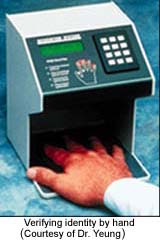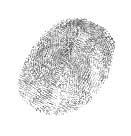December 1998
When Fingerprints Mean Identity
By Cran Sin
Thanks to the new technology known as biometrics verification, one can
now withdraw money from automatic teller machine even if he or she forgets the password.
With this technology, one's identity can be verified by biometrics.
 Biometrics are unique parts of the body and behaviour which can be
divided into two groups - physical and behavioural.
Biometrics are unique parts of the body and behaviour which can be
divided into two groups - physical and behavioural.
Physical biometrics are the inborn characteristics of a person, such
as fingerprints, iris, retina, face, hand shape, DNA and body odour, while examples of
behavioural biometrics include autograph and voice.
For example, iris recognition actually makes use of the unique pattern
of blood vessels over the surface of the eyeball around the iris. The user is defined as valid
if the input biometrics match with the previously encoded record.
Dr. Yeung Dit Yan, associate professor of the Department of Computer
Science of the Hong Kong University of Science and
Technology, has conducted intensive research on biological verification since 1994.
According to Dr. Yeung, this technology means a great step forward for
the security industry.
"It is extremely difficult to fake or copy others' biometrics," he
said.
Even a photocopy of a valid user's fingerprints cannot deceive the
machine.
Said he: "This will not work as the machine scans a three-dimensional
image of the fingers rather than a plane one."
As a result, biometrics verification helps us avoid being cheated by
our own eyes.
"This is what biometrics mean," Dr. Yeung said. "Everyone is unique.
We may not be able to spot the differences between identical twins who look a hundred percent
alike, except for technology."
However, there are some problems in using biometrics verification
method.
Explained Dr. Yeung: "You can be rejected by the computer even if you
are a valid user.
 "It may be due to the wrong angle of scanning the fingerprints, which
makes them look different from the computer record."
"It may be due to the wrong angle of scanning the fingerprints, which
makes them look different from the computer record."
Besides, biometrics can be affected by many other factors.
For example, dry weather will cause a cast of skin, which impairs the
function of the finger scanner. Having the flu will also affect the voice, thus fails voice
recognition.
Poly Security System Limited is a local pioneer, which provides finger
scanning and iris recognition systems for its clients.
However, its director, Mr. Daniel Tsoi, doubts the development
potential of these new security systems, as it is a technology "far too new".
Said he: "So far, there is no order for finger scanners for
residential use, nor demand for iris recognition systems.
"An obstacle to their popularity is that the local security companies
are not yet ready to provide technical support.
 "Obviously, people still prefer to stick to the traditional
machines."
"Obviously, people still prefer to stick to the traditional
machines."
Price is another problem. While a card reader system costs only about
$15,000, the price of a finger scanning system is nearly $30,000.
"I personally think that they're still inconvenient to use," said Mr.
Tsio, "You have to touch the scanner's window very carefully as a little disposition will cause
rejection."
"Also, some people are afraid that their eyes would get hurt when they
use the iris recognition system," he added.
Despite the public's attitude, Dr. Yeung Dit Yan of HKUST still
believes that biometrics verification methods will soon be widely accepted and applied.
"Some of the biometrics verification methods have already developed
into a mature stage, and they are ready for use," said he. "We will enter a new era - an era
when biometrics mean your identity."
Back to Contents
|